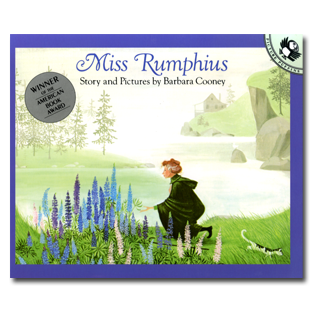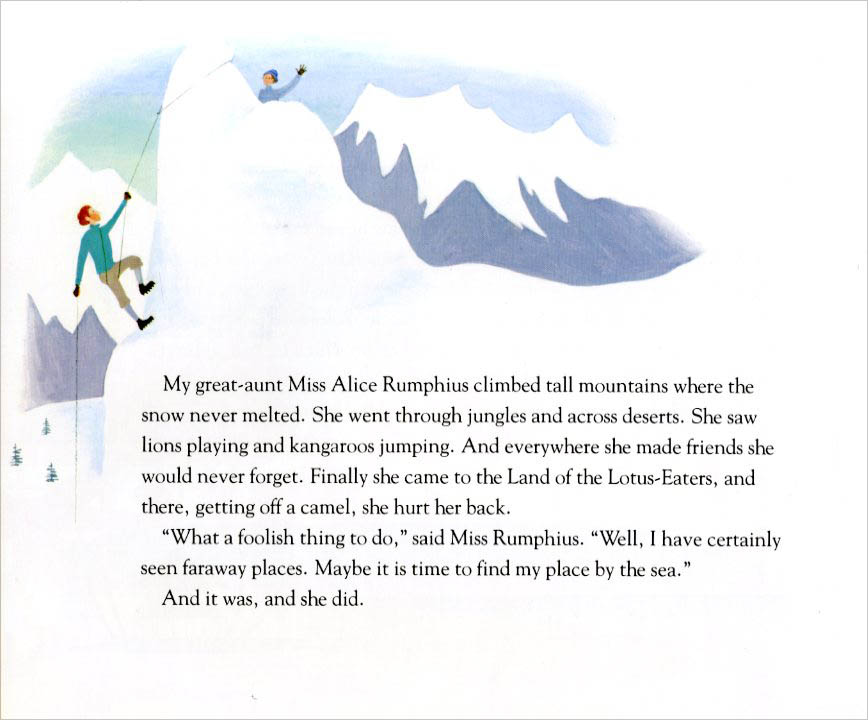
A FEW OTHER EVENTS FOR
MAY 5:
- Happy birthday Scott Westerfeld (Leviathan), Alice Low (The Witch Who Was Afraid of Witches), and Todd Strasser (Boot Camp).
- It’s the birth date of Leo Lionni (1910-1999), Swimmy.
- Happy birthday Carnegie Hall. Originally called The Music Hall, the grand opening of this midtown Manhattan concert venue featured guest conductor Tchaikovsky, in 1891. Read Tchaikovsky Discovers America by Esther Kalman, illustrated by Laura Fernandez and Rick Jacobson.
- In 1925 an arrest warrant was served to John Scopes, for teaching evolution, a violation of Tennessee’s Butler Act. Read The Evolution of Calpurnia Tate by Jacqueline Kelly and Life on Earth: The Story of Evolution by Steve Jenkins.
Starting tomorrow, we celebrate National Wildflower Week (May 6-12th), created by the Lady Bird Johnson Wildflower Center, to “encourage the observations, cultivations and study of native wildflowers.” Today’s book, Miss Rumphius by Barbara Cooney, completely embodies the spirit of this week. In this story a spinster librarian travels around the world and eventually returns to a home by the sea. Wanting to make the world a more beautiful place, she decides to scatter lupine seeds wherever she goes.
Published in November of 1982, when Barbara Cooney lived in Damariscotta, Maine, Miss Rumphius was one of hundreds of books that Cooney, a two-time winner of the Caldecott Award, illustrated in her lifetime. By the time she worked on Miss Rumphius, she had over forty years of experience in children’s book illustrations. An autobiographical picture book, Cooney drew on the life of her great grandfather, who painted pictures and allowed his young daughter, Cooney’s grandmother, to help. “I see that little girl—painting away, making yards and yards of fluffy clouds and sunsets and storms with lightening and rainbows.” Cooney also based the character of Alice Rumphius on an historical figure who traveled the world planting flower seeds. Probably even more important, Alice became what Cooney described as her “alter ego.” She later mused, “Perhaps she had been that right from the start.”
What makes Miss Rumphius memorable for many young readers, however, is the exquisite artwork, executed in the purples, pinks, and blues of the lupines—breathtaking landscapes marked by their beauty and soft color. With its positive and idealistic message of making the world a more beautiful place, this book has captivated both young readers and the parents and teachers who share the book with them. It reminds all of us that with just a little effort we can add beauty to our world.
If you are planting wildflower seeds, pick up a copy of Miss Rumphius, a great read-aloud for kindergarten through third grade, and share it with children and adult friends—both will love it. Not only does Alice Rumphius make the world a more beautiful place by scattering lupines in the story, but Barbara Cooney enhanced our visual world by giving us this breathtaking picture book that we can return to again and again.
Here’s a page from Miss Rumphius: 
Originally posted May 5, 2011. Updated for .













We read this book last semester in Writing I and I absolutely loved it. The illustrations are gorgeous, and I adored the story. I’d like to be the old woman with all the stories one day!
This is absolutely my favorite book because of the message that rings so true – to leave the world a better place than you found it. (and it’s nice to see a strong librarian character too.)
I love the particular place of this book. Lupines grow as beautiful wildflowers in Maine (and up into the Maritimes) but they are fussy down here (outside Boston) and short-lived just a little further South. So just from the illustrations you know you’re in Maine.
I gave this book to my uncle and (grown) cousins for Christmas the year after my aunt had passed, just a week or so before Christmas. It seemed very life affirming. And then they called and said a BIG thank you. Apparently BC wrote a note thanking someone named Hilda (my aunt’s name) at the end of the book. I had always loved this book previously, but now I love it with a fierceness.
This was my most-requested picture book as a child, and I still love it deeply. The page, however, that remains crystal clear in my head to this day is when Alice finds herself in the botanical gardens in the middle of winter, and she closes her eyes and takes a deep breath. There’s something perfect about this page, and I always seek out botanical gardens because of it.
I just discovered this book a few weeks ago, and I was just simply delighted with its art and simple story-line. It was such a wonderful surprise to me meet the Lupin lady! And, it was such a quiet and warm thing. A comfort book for use grown kids, I think.
I loved that the location was clearly near places I think about often. Looking out to sea from the Maine cost is something I need in my life. A friend lived in a place very much like the one in the book, and she and I talked and talked about our love of the little Cape Dory Typhoon sailboats.
This story is such a beautiful little thing. I felt the theme of doing something beautiful for the earth just so healing and life affirming. But then, I’m the kind of kid that has always needed wind, the sea, and the stars. Always will be.
It has some sadness to it which I did not like. Sorry. I’m with the guy that said “No more dead dog stories” Well, the same goes for me, when it comes to Lupin ladies. But I have to own it anyway.
Thanks everyone for your posts. They all bring joy and beauty to my day.
Well, I may get kicked off by the editor for this, but I keep thinking about the beauty of this book’s location. Looking out to sea. Maine. Etc. I’ll try not to get carried away like this too often.
Something kept coming back to me as I read Miss Rumphius, and I don’t wish to detract from that book because I think everyone should go buy it. However, I thought would be fun to share something unusual here.
There is an old book series known as The Rivers of America. The series started in 1937 with the first title being the subject of this post. It was called Kennebec. Cradle of Americans, by Robert P. Tristram Coffin. And that is the book I will share from now. The Kennebec of course, is a river in Maine.
In the book, there are two passages that I will always love, about Maine and its cost.
One passage says that living next to the Kennebec in winter, was like living in the heart of a chandelier.
The other was: (I have loved being in the wind since a child myself.)..
“Wind is a first rate tonic though. It can clean a man’s mind out well. A man coming in out of a wind is apt to be pretty good to his children, I have noticed.” (Cap’n Cy Bibber.)
Another thing mentioned about children that I loved about this Maine book, was something called a Maine Pilgrim basket. (“a stout capacious vessel woven of straw, with a tight-fitting lid. The name has come down with the pattern, no doubt, from the old Canterbury model which held a pilgrim’s lunch and all his earthly goods by day on the holy march and cradled his baby through the night at the inn or in the starlit fields.”)
So, I wonder if the Lupin lady used a Pilgrim basket gather Lupins in. I bet she did.
For those who know Connecticut, The Connecticut – Rivers of America, is available from Amazon.)
Mmmmmm, I love Miss Rumphius! Here’s my story of finding this book. I adore lupines; they make me laugh. If you’re a Monty Python fan, you might remember the character, Dennis Moore – an inept Robinhood figure who raided the rich of their lupines then delivered the stolen flowers to the poor. Ever since seeing this skit, I’ve been a little obsessed with lupines. I’ve tried to grow lupines in Virginia for, oh, twenty years with no luck. So now, I grow Baptisia instead. Miss Rumphius was a gift from a good friend a few years ago who wanted me to have my lupines! Definitely a favorite in our household!
Oh, how the world needs Miss Rumphius right now. If only everyone read this book, we might have peace instead of war and beauty instead of gore.
I carry this book around in my heart every single day.
I had no idea this was based on a true story! That makes it even more wonderful. When I was a little girl, I read Miss Rumphius again and again. I loved going on adventures to faraway places with the Lupine Lady, and her power to turn the world into one big garden seemed like magic. It still does today. Now, I re-read the book several times a year, still in my old paperback copy that is falling to pieces. I realized a couple of years ago that I’d taken Miss Rumphius’ goals as my own. I too want to travel to far away places, live by the sea, and do something to make the world more beautiful. So far, I’ve lived by the sea. I’m working on the rest!
I’ve been reading and rereading this book since I was about five years old. I’m with Sarah – knowing there’s a reality to it makes it that much more beautiful. Barbara Cooney is one of my favorite storytellers in general, although Miss Rumphius sort of exemplifies all that amazingness best for me. Thanks for choosing this one, Anita!
I read this to classes for Earth Day to discuss simple ways we can make the earth better and because I love the book!
When I saw this review again, I felt happy and grateful. A frequent experience from reading books you have lead me to.
Oh how I love this book.
Dear Miss Rumphius;
Thank you for coming to live in my DNA.
Dear Miss Cooney;
Thank you for sending Miss Rumphius to me.
Dear Anita;
As an adult, I have been healed time and again by the winged light of your writing and guidance. If time travel ever becomes possible, come to my early days and tell me you are waiting with these gifts.
A small boy’s head will lean back, his arms will slowly rise, and his spirit will levitate off the ground.
Gordon: Like you, I wish I had known this book as a child. But at least we have it now.
Wonderful book! I’ve read it with my third graders for years… It’s great paired with My Great-Aunt Arizona…two very similar ladies whose lives were at once much the same and very different!